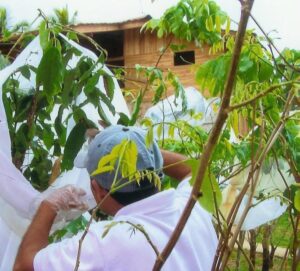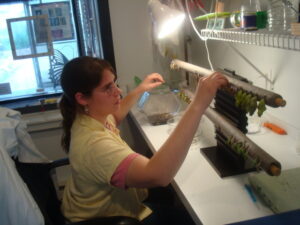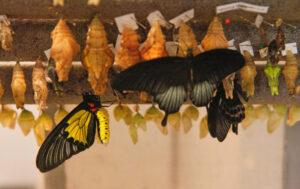The Butterfly Journey
Where do they come from?

Harvesting Blue Morpho Caterpillars in Costa Rica
Currently, the Butterfly House gets butterflies from Asia and Africa, and the North, South, and Central Americas. We receive roughly 350 chrysalises (butterfly pupae) every week from butterfly farms and brokers. At these farms, the butterflies are carefully bred and their eggs raised into hungry caterpillars. The picky caterpillars are fed their appropriate host plants (Monarchs eat only milkweeds, Blue Morphos eat plants in the pea family, etc.) until they are ready to become a chrysalis. The farm workers then set aside some of the chrysalids to become the next generation of breeders, while the rest are carefully packed in cotton or styrofoam trays and shipped express to butterfly houses around the world. Depending on the time of year, farms can be raising anywhere from a handful to dozens of species at a time. At any given time, the Butterfly House has between 60 and 80 species flying around in the garden.
Then what happens?

Diana Cerame, ‘Pinning’ A Shipment From Malaysia
When our shipments arrive, they are taken into our laboratory and all the chrysalids are carefully inspected by one of our entomologists. They are then hung on foam-covered rods and are placed in our emergence chamber, where they continue transforming from a caterpillar to an adult butterfly. The incubator is on display for some lucky guests to see the butterflies emerge from their chrysalises in real time. It’s a sight to see!
When a butterfly emerges, its body is swollen with fluid and its wings are tiny and folded up from being inside the chrysalis. The struggle of coming out of the chrysalis starts the flow of fluid from the body into the veins of the wings, filling them in much the same way a raft is inflated. The wings will become fully inflated within the first 20 minutes of drying, but the hard work isn’t over yet. The butterfly continues to hang upside down from it’s empty chrysalis case until its wings are completely dry, which can take up to 4 hours. Once they are ready to fly, they are carefully collected and released in to the garden at 10:30am and 4:30pm, its well worth the visit!
Ready to Fly!

Photo by CandaceWest.com
In our garden, the butterflies act just as they would in the wild. They fly from flower to flower drinking nectar, collect on our plates of overripe banana slices to drink the juices, stretch out on a leaf to bask in the sun, defend their territories from other butterflies, and mate. Although butterflies do mate in our garden, the females will not lay their eggs unless they find the host plant their species needs as a cateripllar (ex: Monarchs won’t lay their eggs if there is no milkweed to be found). We are very careful to not plant any host plants in our garden, so our female butterflies never lay their eggs. Raising caterpillars in the garden is prohibited by the USDA since almost all of our butterflies are foreign, and they must be carefully controlled and contained so that they don’t pose a threat to the outside environment.
Jo, Nikki, and Noel - “Thanks for caring so much, and helping everyone to appreciate butterflies.”
Terry and Penny - “Very educational.”
Caitlin - “I was surprised by how active the butterflies were.”
